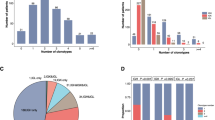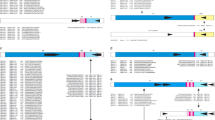Abstract
Immunoglobulin heavy chain gene (IgH gene) rearrangements are found in the majority of patients with B lineage acute lymphoblastic leukaemia (ALL). Two hundred and three bone marrow samples from 54 patients (33 adults and 21 children) were analysed by PCR within specific time-points after diagnosis (ie 1, 2–3, 4–6 and 7–12 months) using FR1 and JH primers (fingerprinting with a sensitivity ⩾1:5 × 103). CDR3-derived allele specific oligoprimers (ASO to achieve a sensitivity between 1:104 and 1:105) were applied to 12 children and 18 adults, while size of CDR3 region, oligoclonality and background problems prevented their application to the remaining patients. All patients were followed clinically for ⩾24 months. Thirty adults and 16 children presented as newly diagnosed ALL, while the remaining eight patients were analysed in first or subsequent relapse. Patients destined to relapse showed a higher proportion of positive tests (⩾50%), particularly after 1 month, than in the remission group, irrespective of age. Among patients staying in remission, a decrease in MRD-positive tests occurred during the first 12 months in both age groups. However, the proportion of positive tests dropped below 15% at a later stage in adults (4–6 months) than in children (2–3 months). Among children, only patients destined to relapse were MRD positive beyond 1 month, with the exception of only one patient, still positive at 2–3 months in the remission group. The difference in MRD positivity between relapse and remission patients was statistically significant in children (P < 0.03) at any time of testing, but only at 4–6 months in adults (P < 0.01). these data suggest that resolution of mrd in all occurs more rapidly in children compared to adults, particularly within the first 6 months. children and adults, studied in first or subsequent relapse, showed a higher proportion of positive tests during reinduction compared to newly diagnosed patients.
This is a preview of subscription content, access via your institution
Access options
Subscribe to this journal
Receive 12 print issues and online access
$259.00 per year
only $21.58 per issue
Buy this article
- Purchase on Springer Link
- Instant access to full article PDF
Prices may be subject to local taxes which are calculated during checkout
Similar content being viewed by others
Author information
Authors and Affiliations
Rights and permissions
About this article
Cite this article
Foroni, L., Coyle, L., Papaioannou, M. et al. Molecular detection of minimal residual disease in adult and childhood acute lymphoblastic leukaemia reveals differences in treatment response. Leukemia 11, 1732–1741 (1997). https://doi.org/10.1038/sj.leu.2400841
Received:
Accepted:
Issue Date:
DOI: https://doi.org/10.1038/sj.leu.2400841
Keywords
This article is cited by
-
MRD in ALL: Optimization and Innovations
Current Hematologic Malignancy Reports (2022)
-
Flow Cytometry Based MRD and Its Impact on Survival Outcome in Children and Young Adults with ALL: A Prospective Study from a Tertiary Cancer Centre in Southern India
Indian Journal of Hematology and Blood Transfusion (2020)
-
Novel therapies for relapsed acute lymphoblastic leukemia
Current Hematologic Malignancy Reports (2009)
-
Flow cytometric follow-up of minimal residual disease in bone marrow gives prognostic information in children with acute lymphoblastic leukemia
Leukemia (2003)
-
Serial minimal residual disease (MRD) analysis as a predictor of response duration in Philadelphia-positive acute lymphoblastic leukemia (Ph+ALL) during imatinib treatment
Leukemia (2003)



